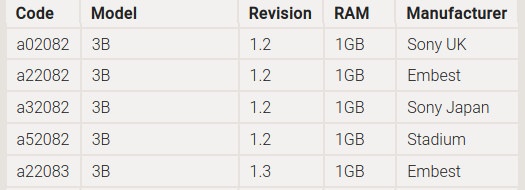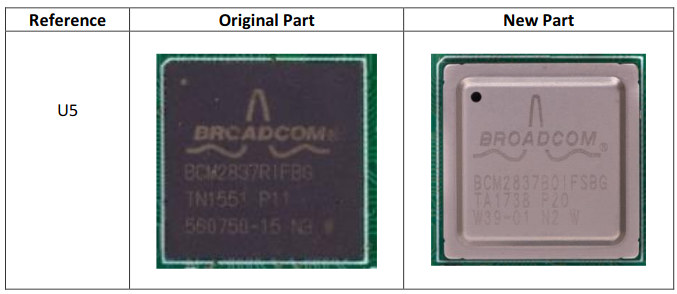As we’ve recently seen with Raspberry Pi 4 v1.2, the Raspberry Pi Foundation will sometimes provide new revisions of their boards with small differences or fixes that most users won’t notice, so they will not make announcements about those minor revisions.
Somebody on the RPi forums noted there may be a “new version of Raspberry Pi 3B“, and the discussion points out there are actually two such revisions that are mass-produced from various companies.
It turns out the Foundation also posted PCN (Product Change Notices) on the product page of their boards, so we can know exactly what has changed and when.
The fist PCN for v1.2 board is dated November 1, 2018, and explains the SoC has changed switching from BCM2837 to BCM2837B0 found in Raspberry Pi 3B+ but with frequency limited to 1.2 GHz.
The PCN further explains the timing of the change:
The new part will be phased into manufacturing from January 2019 in both China and UK factories. There will be a transition period where both old and new units are available in the distribution channel.
The second PCN – 19th December 19, 2019 – states the change will impact all Raspberry Pi 3B boards, including the ones manufactured in Japan. Note that when Raspberry Pi 3B launch in 2016 the PCB was already revision v1.2, so there are no changes to the PCB itself.
I suspect the change will only affect a few people, since sales of Raspberry Pi 3B boards have likely plummeted, and the board will be the same except for one point:
New part, BCM2837RIFSBTB0T has a Z height which is 1.06mm higher than the original part, BCM2837RIFBGT.
That means if you have one of those metal cases designed with an extrusion to cool the processor on the original Raspberry Pi 3B board and buy a new Raspberry Pi 3B it may not fit in the case. Other than that, there should be no differences, and the software is the same.
What about Raspberry Pi 3B v1.3 you may ask… I just don’t know since I haven’t been able to find details, but I suspect BCM2837 processor is not mass-produced anymore and must be using BCM2837B0 like v1.2, plus some other undocumented changes.
Thanks to RaspberryParaTorpes for the tip.

Jean-Luc started CNX Software in 2010 as a part-time endeavor, before quitting his job as a software engineering manager, and starting to write daily news, and reviews full time later in 2011.
Support CNX Software! Donate via cryptocurrencies, become a Patron on Patreon, or purchase goods on Amazon or Aliexpress






